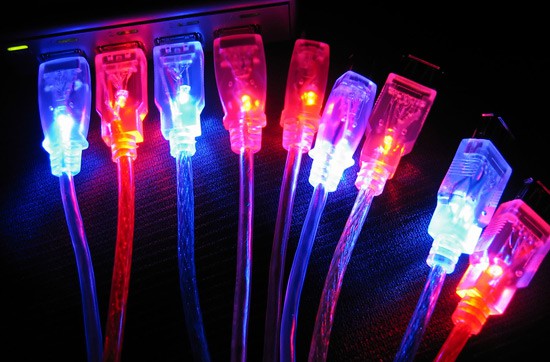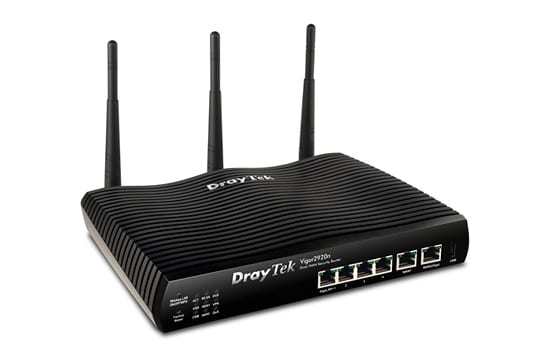What can you do when you have applied all the broadband speed enhancement techniques described on this site, but you have multiple users and/or devices and your limited ADSL or ADSL2+ speeds are becoming a major bottleneck? Leased lines can be extremely expensive. The simple answer is to use more than one broadband connection. With the increasing availability of Local Loop Unbundled (LLU) services, using more than a single ADSL connection is surprisingly affordable. Not only can multiple connections speed up Internet access for users, it can provide much-valued resilience – so that you are not disconnected from the Internet if a single line goes down.
Why use more than one broadband connection?
While the availability of faster broadband services is improving (as described in our Superfast and Ultrafast Broadband page), some businesses and homes (particularly in more rural areas) remain dependent on ADSL or ADSL2+ services. This is despite the fact that demands for bandwidth continue to increase.

In this website, we have presented a range of techniques that can be applied to squeeze the very best speeds from a single ADSL or ADSL2+ broadband connection. These include:
- tweaking of the target signal-to-noise ratio
- installation of a filtered faceplate
- moving to ADSL2+ from basic ADSL
- using a more robust modem (such as the Billion 7800DXL).
Many broadband users find that the combination of these approaches can substantially improve the reliability and speeds of their broadband connection.
However, once you have extracted the very best performance from your ADSL or ADSL2+ connection, what options are there to improve speeds further? A dedicated leased line is a possible option but this can be highly expensive. Thankfully, there is a more cost-effective solution. Once you’ve reached the ‘end of the line’ with improvements for a single line (pardon the pun), the answer is to use more than one connection.
As well as providing greater bandwidth, multiple connections can provide resilience, which may be particularly valued by business users. With multiple connections, if one broadband connection fails (for example, due to a line fault), Internet connectivity is still retained.
There may be compelling reasons for using multiple connections even for businesses located in areas where fibre broadband is available. For example, businesses may be seeking resilience to avoid the ‘disaster scenario’ of completely losing Internet connectivity. Also, just because fibre broadband is available does not mean that speeds are very high. As described in our Chart of BT fibre broadband speed against distance from the cabinet article, fibre broadband speeds diminish as the distance from the street cabinet increases. So, businesses located over 1.6 km from a fibre street cabinet may only achieve download speeds of less than 20 Mbps.
True ADSL bonding or dual-WAN (multi-WAN) routers
There are a number of ways in which you can use multiple ADSL or ADSL2+ lines, by employing:
- true ADSL, ADSL2+ or fibre broadband bonding, which is available from Sharedband, Eclipse Internet and Evolving Networks
- a dual/multi-WAN router with load balancing capabilities
- a dual/multi-WAN router with ‘fail over’ or ‘fail back’ capabilities.
Each of these solutions provides improved resilience compared with a single connection, particularly when separate telecom providers are used for each individual line. However, these techniques differ in some important aspects, which we will now consider.
ADSL bonding provides the best performance
As described on our ADSL bonding page, ADSL bonding solutions provide the best performance by amalgamating disparate connections into a single, combined connection. So, for example, two ADSL2+ connections, each delivering 4 Mbps (download) and 1 Mbps (upload), could be combined to form a single connection, delivering nearly 8 Mbps (download) and 2 Mbps (upload). Similarly, four ADSL2+ connections of the same speed could deliver nearly 16 Mbps (download) and 4 Mbps (upload).
Currently, ADSL bonding is offered by:
- Evolving Networks
- Sharedband
- Eclipse Internet (a reseller of the Sharedband solution).
The ISP Be, which has also offered line bonding, has withdrawn its ADSL/ADSL2+ bonding service after being bought by Sky. We believe that this is simply due to Sky’s focus on its current broadband product range, which does not include bonded services.
Evolving Networks

Evolving Networks provides true bonding solutions for a range of technologies, including ADSL, ADSL2+ and fibre broadband. Evolving Networks provides a complete solution that includes provision of broadband lines to achieve full control of the service offered. Evolving Networks positions itself as a premium supplier of bonded solutions. Its bonded solutions are delivered uncontended. It also offers compression and quality of service to maximise performance.
We have undertaken a long-term trial of bonded services from Evolving Networks, which includes the bonding of two ADSL connections, a fibre FTTC connection bonded with ADSL2+ (to provide resilience) and the bonding of two FTTC fibre connections. Click on the following links to read our reviews of bonded ADSL from Evolving Networks:
Review of Bonded ADSL From Evolving Networks (Part 1)
Bonding Three and Four ADSL Lines (Part 2)
Sharedband

Sharedband claims that its bonding service can achieve download and upload throughputs that are close to the sum of the throughputs of the individual lines bonded. The Sharedband service works independently of any ISP, so it is not dependent on the availability of any particular broadband service provider. Therefore, it is available to all UK broadband users and can be used with existing broadband services. Since the Shareband service can use ADSL or ADSL2+ connections from different network providers, extra resilience can be achieved by deliberately selecting independent providers for each line.
Read our review of bonded ADSL from Sharedband
Load-balancing routers help to support multiple simultaneous users and devices
A number of manufacturers (for example, DrayTek) produce so-called ‘load balancing’ routers. These incorporate more than one WAN input so can be connected to two or more ADSL/ADSL2+ modems.
Through complex processing, a load balancing router allows multiple connections to be utilised and attempts to match the demand of the broadband users and devices attached to it with the available capacity, splitting traffic across two or more broadband connections.
It is important to note the limitation of load-balancing routers, however. While some people incorrectly refer to dual-WAN routers as being able to ‘bond’ two (or more) broadband connections together, this is technically not the case. For example, a dual-WAN load-balancing router does not transform two 3 Mbps connections into a combined connection of 6 Mbps. It simply allows traffic to be carried along any one of the connections available with the maximum speed for the particular user/application being limited to the maximum speed of the single broadband connection. So, a 4 Mbps video feed could not be viewed with two 3 Mbps broadband connections, for example.
 Not all load-balancing routers are the same! Routers differ substantially in the extent to which they can manage traffic efficiently and effectively, and in a balanced way. Effective load balancing requires a significant amount of processing within the load balancing router.
Not all load-balancing routers are the same! Routers differ substantially in the extent to which they can manage traffic efficiently and effectively, and in a balanced way. Effective load balancing requires a significant amount of processing within the load balancing router.
As a result, more expensive routers tend to give superior results, and generally provide more user control on how multiple connections are used.
Results from high-quality load-balancing routers can be excellent in terms of supporting a greater number of simultaneous users compared with a single ADSL line, while also providing the resilience benefits that two or more ADSL connections can provide. However, it is important to realise the limitations of load balancing routers compared with bonded solutions.
The use of load-balancing routers can be restrictive when the speeds of the individual lines are relatively low. This is because low single-connection speeds would not allow a full range of services (such as video streaming) to be carried. This is where true line bonding can be highly beneficial. For example, bonding two 2 Mbps (downlink) connections to deliver a connection of nearly 4 Mbps would allow an HD video stream (e.g. iPlayer) to be accessed whereas this would not be possible with a load-balancing router.
Dual/multi-WAN routers with fail-over/fail-back provide resilience benefits only
There are a number of dual-WAN routers available that offer basic fail-over/fail-back capabilities. Broadband users that are concerned about the reliability of their Internet connections can connect two separate lines to such a router. The router automatically switches to the working ADSL connection if the other connection fails (for example, due to a line fault or a failure in part of the ISP’s network).
It is important to realise that, apart from resilience, dual-WAN routers equipped with fail-over/fail-back do not give speed or capacity benefits, since one of the broadband connections always remains unused. While buying a dual-WAN router with basic fail-over/fail-back capabilities may seem to be the cheapest solution, this may not necessarily be the case since there may be none of the potential benefits associated with sharing traffic among several connections.
Multiple lines bring significant benefits
As we have shown, using multiple ADSL connections can bring significant benefits, particularly for small businesses and consumers struggling with poor broadband speeds and/or poor broadband service reliability. Today, the costs associated with multiple lines are much more affordable than they were several years ago. Having more than one line really is a viable proposition for many. You may find that costs may not actually increase compared with your present service, particularly if you currently use BT services.
Depending on the speeds achieved by your broadband connection(s), a load-balanced router may provide a cost-effective way of providing benefits from having more than one line. For broadband users with the slowest speeds, true bonding offers the potential of transforming your Internet experience by enabling the greatest number of services (such as streaming video).
You may be interested in reading our most popular pages and guides:
To get the most from your broadband connection, read our Increase Broadband Speed Guide.
WiFi could currently be the bottleneck of your broadband connection. To get the very best speeds, read our Wi-Fi Optimisation guide.
